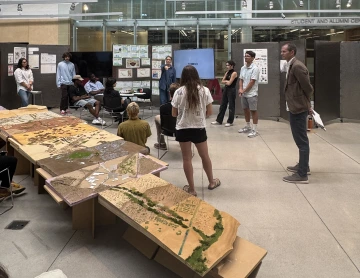Guiding a New Era: Kirk Dimond, Landscape Architecture Program Chair and Associate Professor

10 Questions with Kirk Dimond, Landscape Architecture Program Chair and Associate Professor
“My goal as chair is to build on our program’s strengths by fine-tuning systems and resources to create more efficiency and balance.”
Dimond was recently named program chair for the landscape architecture program at CAPLA. Hear about his background in the field and vision for the future.
What got you into landscape architecture?
My father’s excavation work and my mother's encouragement toward college sparked my interest in construction and design, initially drawing me to architecture. I took some drafting classes in high school to prepare, but we had some guest architects that provided a sour perspective of practice that prompted me to explore engineering as an alternative. I then stumbled into landscape architecture by chance after receiving program information, and was drawn by the blend of environmental and social sciences, technology, art and design, piquing a range of interests within me.
What brought you to CAPLA and the U of A?
The West called me back after six years in the East. As I was finishing up my undergraduate degree, I had informed one of my professors that the last thing I would want to do is teach. However, that changed for me in grad school in Pennsylvania. Upon finishing, I worked as an instructor and academic advisor for architecture, landscape architecture and graphic design for a few years. At that point, I decided to apply for a PhD program that I could do while continuing in my position. As I prepared my application, I glanced at open faculty positions across the country and this position 2,200 miles away at CAPLA was the single one that spoke to me and the only one I applied for. I received my acceptance to the PhD program the day I returned from interviewing, but knew at that time that Tucson would be my new home!
Are you currently practice in the field of landscape architecture?
I’m currently focusing on research, teaching and service, but my architecture faculty colleagues inspired me with their commitment to licensure. I recently passed all the sections of the Landscape Architecture Registration Exam (LARE) and I’m now wrapping up the final steps toward becoming licensed.

Associate Professor Kirk Dimond teaches Design Studio III with third-year BLA and second-year MLA students.
What are you teaching this semester, and what do you most enjoy about teaching?
This semester, I am teaching Design Studio III with 3rd year BLA and 2nd year MLA students. We have been working hard to comprehend watersheds and use innovative means to understand context for site design. What I enjoy most is guiding students through their design process and reaching that “aha” moment where they connect ideas in ways they hadn’t considered before.
As the new program chair for the landscape architecture program, what are your goals and what can students expect?
My goal as chair is to build on our program’s strengths by fine-tuning systems and resources to create more efficiency and balance. I value both our blossoming undergraduate program and our established and regarded graduate program. Ensuring that each program supports and complements the other will foster a richer, more cohesive educational experience.
What makes the landscape architecture program unique/special?
Our programs have always benefited from an intimate culture. We’re relatively small among university programs, so all faculty and students get to know each other very well. It’s like being at a small college from a social and educational perspective, but with all the resources and collaborations that come with being at a major university – best of both worlds. Further, our Sonoran Desert setting provides a “living lab” experience that teaches resilience, biodiversity, adaptation and more. This landscape brings lessons in design and sustainability that you really can’t find anywhere else!
Landscape architecture can be misunderstood by the general public. How would you describe the impact of landscape architecture professionals?
Landscape architects are often misunderstood as primarily dealing with plants, but our work goes far beyond that. We balance plant materials, with topography, architectural elements and water while integrating ecological, social and physical analyses. A successful landscape design often goes unnoticed because it feels natural and intuitive—unlike in architecture, where the building is a clear and prominent outcome.
How would you describe the landscape architecture community within CAPLA?
When I first entered the profession, I had an architecture colleague once tell me that I’ll love working with other landscape architects because they are mostly “laid-back hippy folk.” While maybe not completely true, I do find the landscape architecture community within CAPLA and beyond to be warm, welcoming and collaborative, embodying a professional humility that reflects a shared commitment to improve the environments around us. I believe we’re a small but open group that is always happy to support each other in our common goal of advancing design for the human (and non-human) good.
What advice do you have for students?
My advice is to always keep learning and doing. Our professional programs are just the beginning of a journey that will deepen and broaden as your career progresses, and I hope our students will always embrace it!
Beyond teaching, what are your passions?
My passions are broad, much like my interests as a generalist. I try to balance my passions in four areas including: physical (hiking, biking, basketball, volleyball, racket sports), social (family, cooking/baking, travel), intellectual (making/building, sketching, non-fiction reading, math/science) and spiritual (faith, stewardship, community and cross-denominational connections).



